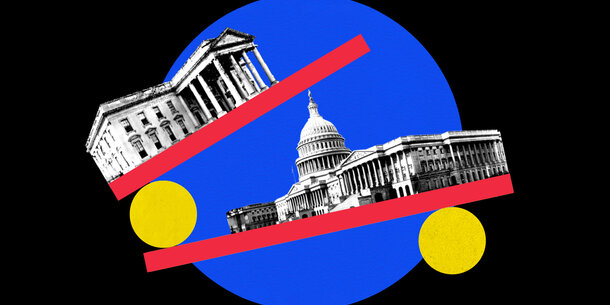This article originally appeared in Defense One
One year ago, a mix of soldiers and federal law enforcement, wielding tear gas and shooting rubber bullets, cleared a crowd of people lawfully protesting police brutality after the murder of George Floyd from Washington, D.C.’s Lafayette Square. Then-President Donald Trump and Attorney General William Barr had orchestrated the operation so the president could pose for a photoshoot at St. John’s Episcopal Church. At the same time, thousands of Guardsmen from eleven states deployed into Washington at Trump’s invitation, over the objections of D.C. Mayor Muriel Bowser.
By directing the National Guard to police protests in D.C. and threatening to use the military around the country, Trump violated longstanding norms keeping our military above the political fray, including the bedrock democratic principle known as posse comitatus. Nearly 150 years ago, Congress enshrined that principle into law with the Posse Comitatus Act, which prohibits the use of federal military force for domestic policing except as specified by law. Yet Trump and Barr exploited loopholes in the Act to flood downtown D.C. with troops without any express congressional authorization.
A year later, those loopholes remain wide open, threatening civilians’ constitutional rights— including the fundamental right to protest government policies and practices. Now is the time for Congress to close them to prevent another Lafayette Square under a future administration. Three fixes would go a long way in addressing the problems that allowed President Trump to militarize D.C., and they should be on the table as Congress considers defense authorization legislation over the coming weeks.
First, Congress should rethink the command structure of the D.C. National Guard. In every other state or U.S. territory, the Guard is under the governor’s command and control unless called into federal service. Only the D.C. National Guard is always under the president’s command and control—a relic of an era when D.C. had no local government and was entirely under federal rule. Despite this arrangement, the Department of Justice has long endorsed the legal fiction that D.C.’s Guard, like other state Guard units, can operate in non-federal status. And because the Posse Comitatus Act only applies to Guard forces when they have been federalized, that means the president can use the D.C. Guard to conduct domestic law enforcement at will, without having to invoke any statutory exemption to the Posse Comitatus Act.
The president’s control over the D.C. National Guard also hampers its flexibility in an emergency. A vivid example of that problem occurred on Jan. 6. When the attack on the Capitol complex began, the mayor immediately requested deployment of the Guard, but it took over an hour for the executive branch to approve the request and over three hours for Guard forces to reach the Capitol.
A simple fix to both problems would be to align D.C. with every other state and territory by transferring control of its Guard forces from the president to D.C.’s mayor. This would allow the mayor to act quickly and flexibly to use the Guard for law enforcement purposes. The president could still assume command of the Guard by calling it into federal service, but the Guard would then be bound by the Posse Comitatus Act and could be used for policing purposes only as allowed by law.
Second, Congress should clarify that governors may not deploy their Guard units into other states or territories without those jurisdictions’ consent. This limitation is arguably inherent in the Constitution. Nonetheless, Barr claimed that a law permitting National Guard units to operate in “hybrid status”—namely, carrying out federal missions while remaining under state command and control—allows governors to deploy their Guard forces out of state even if the host state or territory objects.
This unprecedented interpretation not only threatens state sovereignty; it further undermines the principle of posse comitatus. In hybrid status, Guard units are exempt from the Posse Comitatus Act because they are operating under state command. A key element of state command is the governor’s ability to decline a given federal mission. If, however, any governor can send Guard forces into any other jurisdiction, the right to refuse becomes illusory. All the president would need is one willing governor in order to use Guard forces as a domestic police force anywhere in the country. Last June, President Trump found eleven.
Finally, Congress must ensure that the applicability of posse comitatus turns on the facts on the ground, not on legal nomenclature. Out-of-state Guard troops in D.C. last June were exempt from the Posse Comitatus Act because they were nominally under the command and control of their governors. In practice, though, Defense Department officials confirmed that those out-of-state units reported up through the D.C. National Guard’s chain of command—to the president. To ensure future presidents can’t use state governors as cover to wield the National Guard as federal police, Congress should clarify that the Posse Comitatus Act applies in any situation where National Guard units report up to the president or the president’s designee.
To be sure, there can be legitimate reasons for the president to deploy troops domestically, such as providing disaster relief, repelling invasion, or enforcing civil rights laws. Congress has provided ample authority for the president to use the military for those purposes, and none of the above reforms would prevent a president from lawfully exercising those powers. Rather, these reforms would close dangerous loopholes to prevent the National Guard from being abused, misused, or dragged into partisan politics.
As our democracy comes under increasing strain, reforms are needed to harden our institutions against future abuses. Ensuring that the president cannot use the National Guard as a federal police force on a whim must be a key part of that project.



